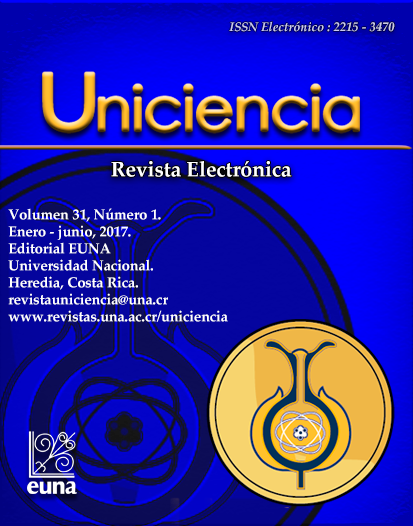Dinámica anual de tintínidos en las aguas estuarinas de dos áreas marinas de pesca responsable en el Golfo de Nicoya, Costa Rica
DOI:
https://doi.org/10.15359/ru.31-1.1Palabras clave:
Tintínidos, plancton, biodiversidad, estuarioResumen
En los periodos de marzo de 2012 a marzo de 2013, y de setiembre del 2013 a agosto del 2014, se determinó la biodiversidad y abundancia de tintínidos y su relación con variables ambientales, en dos áreas marinas de pesca responsable (AMPR) (Puerto Níspero y Paquera) del Golfo de Nicoya, Costa Rica. Para ambas zonas de muestreo se determinó una estacionalidad de los parámetros físico-químicos influenciada por variabilidad climática de la zona, lo cual se evidenció con las diferencias significativas en el tiempo de muestreo. La población de tintínidos reflejó una baja diversidad de especies donde los principales representantes fueron Tintinnopsis parva, T. uruguayensis y Tintinnidium balechi; y su abundancia osciló entre un rango de 0 a 5583 cél L-1. Al correlacionar la abundancia de tintínidos con respecto a las variables ambientales estudiadas en cada sitio de muestreo, se determinó una tendencia a que las interacciones significativas fueran negativas, principalmente entre la abundancia de tintínidos y la concentración de oxígeno disuelto en ambas AMPR. También, al interrelacionar las variables ambientales respecto al comportamiento temporal de la abundancia de tintínidos, se determinó que sí hay una relación entre el aumento en la concentración de los organismos y la variación ambiental. A nivel general, la presencia de tintínidos evidencia el proceso natural de la cadena trófica, al garantizar una dinámica productiva en la base de la cadena alimenticia de las zonas de estudio.
Referencias
Abou Zaid, M. M. & Hellal, A. M. (2012). Tintinnids (Protozoa: Ciliata) from the coast of Hurghada Red Sea, Egypt. Egyptian Journal of Aquatic Research, 38, 249-268. http://dx.doi.org/10.1016/j.ejar.2013.01.003
Alder, V. A. (1999). Tintinnoidea. En D- Boltovskoy, (Ed.), South Atlantic Zooplankton, (Vol. II, pp. 321-384). Leiden, The Nerthelands: Backhuys Publishers.
Brenes, C. & León, S. (1995). Hidrografía del Golfo de Nicoya, Costa Rica. Ponencia presentada en el Simposium Ecosistemas de Manglares en el Pacífico Centroamericano. San Salvador, El Salvador.
Brenes C. (2001). Fundamentos de oceanografía descriptiva: Aplicación al istmo centroamericano. Nicaragua: Proyecto para el Desarrollo Integral de la Pesca Artesanal en la Región Autónoma Atlántico Sur (DIPAL).
Brenes, C. L., Leon, S., & Chávez, J. (2001). Variación de las propiedades termohalinas en el Golfo de Nicoya, Costa Rica. Revista de Biología Tropical, 49, 145-152.
Cariou, J. B., Dolan, J. R. & Dallot, S. (1999). A preliminary study of tintinnid diversiy in the NW Mediterranean Sea. Journal of Plankton Research, 21(6), 1065-1075. http://dx.doi.org/10.1093/plankt/21.6.1065
Dolan, J. R., Ritchie, M. E., Tunin-Ley, A. & Pizay, M. D. (2009). Dynamics of core and occasional species in the marine plankton: Tintinnid ciliates in the north-west Mediterranean Sea. Journal of Biogeography, 36, 887-895. http://dx.doi.org/10.1111/j.1365-2699.2008.02046.x
Elliot, D. T. & Kaufmann, R. S. (2007). Spatial and Temporal Variability of Mesozooplankton and Tintinnids Ciliates in a Seasonally Hypersaline Estuary. Estuaries and Coasts, 30(3), 418-430. http://dx.doi.org/10.1007/BF02819388
Epifanio, C. E., Maurer, D. & Dittel, A. I. (1983). Seasonal changes in nutrients and dissolved oxygen in the Gulf of Nicoya, a tropical estuary on the Pacific coast of Central America. Hydrobiologia, 101, 231-238. http://dx.doi.org/10.1007/BF00009879
Feng, M., Zhang, W., Wang, W., Zhang, G., Xiao, T. & Xu, H. (2015). Can tintinnids be used for discriminating water quality status in marine ecosystems? Marine Pollution Bulletin. http://dx.doi.org/10.1016/j.marpolbul.2015.10.059
Gómez, O. (1997). Los tintínidos (Protozoa: Ciliata) del mar peruano y sus relaciones con el fenómeno El Niño. Boletín del Instituto del Mar de Perú, 16(2), 61-84.
Hammer, Ø.; Harper, D. A. T. & Ryan, P. D. (2001). PAST: Paleontological Statistics software package for education and data analysis. Paleontologia Electronica 4(1), 9.
Hinder, S. L., Manning J. E., Gravenor, M. B., Edwards, M., Walne, A. W., Burkill, P. H. & Hays, G. C. (2012). Long-term chages in abundance and distribution of microzooplankton in the NE Atlantic and North Sea. Journal of Plankton Research, 34(1), 83-91. http://dx.doi.org/10.1093/plankt/fbr087
Jiang, Y., Yang, J., Al-Farraj, S. A., Warren, A. & Lin, X. (2012). Redescriptions of three tintinnids ciliates, Tintinnopsis tocantinensis, T. radix and T. cylindrical (Ciliophora, Spirotrichea), from coastal waters off China. European Journal of Protistology, 48, 314-325. http://dx.doi.org/10.1016/j.ejop.2012.02.001
Kamiyama, T. & Tsujino, M. (1996). Seasonal variation in the species composition of tintinnid ciliates in Hiroshima Bay, the Seto Inland Sea of Japan. Journal of Plankton Research, 18(12), 2313-2327. http://dx.doi.org/10.1093/plankt/18.12.2313
Kress, N., León, S., Brenes, C., Brenner, S. & Arroyo, G. (2001). Horizontal transport and seasonal distribution of nutrients, dissolved oxygen and chlorophyll-a in the Gulf of Nicoya, Costa Rica: a tropical estuary. Continental Shelf Research, 22(1), 51-66. http://dx.doi.org/10.1016/S0278-4343(01)00064-4
Li, H., Zhao, Y., Chen, X., Zhang, W., Xu, J., Li, J. & Xiao, T. (2015). Interaction between neritic and warm water tintinnids in surface waters of East China Sea. Deep-Sea Research II, http://dx.doi.org/10.1016/j.dsr2.2015.06.008
Lizano, O. & Vargas, J. (1994). Distribución espacio-temporal de la salinidad y la temperatura en la parte interna del Golfo de Nicoya. Tecnología en Marcha, 12(2), 3-16.
Moscatello, S., Caroppo, C., Hajdëri, E. & Belmonte, G. (2011). Space Distribution of Phyto- and Microzooplankton in the Vlora Bay (Southern Albania, Mediterranean Sea). Journal of Coastal Research, 58, 80-94. http://dx.doi.org/10.2112/SI_58_8
Rakshit, D., Kumar Sarkar, S., Deb Bhattacharya, B., Jonathan, M. P., Kumar Biswas, J., Mondal, P. & Mitra, S. (2015a). Human-induced ecological changes in western part of Indian Sundarban megadelta: A threat to ecosystem stability. Marine Pollution Bulletin, 99, 186-194. http://dx.doi.org/10.1016/j.marpolbul.2015.07.027
Rakshit, D., Sankar Ganesh, P. & Kumar Sarkar, S. (2015b). Choreotrich ciliate tintinnid (Protozoa: Ciliophora) in a tropical meso-macrotidal estuary, eastern part of India. Regional Studies in Marine Science, http://dx.doi.org/10.1016/j.rsma.2015.06.003
Raybaud, V., Tunin-Ley, A., Ritchie, M. E. & Dolan, J. R. (2009). Similar patterns of community organization characterize distinct groups of different trophic levels in the plankton of the NW Mediterranean Sea. Biogeosciences, 6, 431-438. http://dx.doi.org/10.5194/bg-6-431-2009
Reid, F. M. H. & Stewart, E. (1989). Nearshore microplaktonic assemblages off southern California in Febrary 1983 during the El Niño event. Continental Shelf Research, 9, 37-50. http://dx.doi.org/10.1016/0278-4343(89)90081-2
Santoferrara, L. & Alder, V. (2012). Abundance and diversity of tintinnids (planktonic ciliates) under contrasting levels of productivity in the Argentine Shelf and Drake Passage. Journal of Sea Research, 71, 25-30. http://dx.doi.org/10.1016/j.seares.2012.04.002
Sitran, R., Bergamasco, A., Decembrini, F. & Guglielmo, L. (2007). Temporal succession of tintinnids in the northern Ionian Sea, Central Mediterranean. Journal of Plankton Research, 29(6), 495-508. http://dx.doi.org/10.1093/plankt/fbm032
Solano-León, E. (2012). Resumen meteorológico diciembre de 2012. Boletín Meteorológico Mensual. Departamento de Meteorología Sinóptica y Aeronáutica (DMSA) Instituto Meteorológico Nacional, Costa Rica. Recuperado de https://www.imn.ac.cr/documents/10179/14635/DICIEMBRE
Suthers, I. & Rissik, D. (2009). Plankton: a guide to their ecology and monitoring for water quality. Collingwood, Victoria, Australia: CSIRO Publishing.
Thompson, G. A., Alder, V. A. & Boltovskoy, D. (2001). Tintinnids (Ciliophora) and Other Net Microzooplankton (>30µm) in South-western Atlantic Shelf Break Waters. Marine Ecology, 22(4), 343-355. http://dx.doi.org/10.1046/j.1439-0485.2001.01723.x
Trottet, A., Roy, S., Tamigneaux, E. & Lovejoy, C. (2007). Importance of heterotrophic planktonic communities in a mussel culture environment: Grande Entrée laggon, Magdalen Islands (Québec, Canada). Marine Biology, 151, 377-392. http://dx.doi.org/10.1007/s00227-006-0494-y
Verity, P. (1985). Grazing, repiration, excretion, and growth rates of tintinnids. Limnology and Oceanography, 30(6), 1268-1282. http://dx.doi.org/10.4319/lo.1985.30.6.1268
Villate, F., Uriarte, I., Pilar Olivar, M., Maynou, F., Emelianov, M. & Ameztoy, I. (2014). Mesoscale structure of microplankton and mesoplankton assemblages under contrasting oceanographic conditions in the Catalan Sea (NW Mediterranean). Journal of Marine Systems, 139, 9-26. http://dx.doi.org/10.1016/j.jmarsys.2014.05.004
Voorhis, A., Epifanio, C., Maurer, D., Dittel, A. & Vargas, J. (1983). The estuarine character of the Gulf of Nicoya, an embayment on the Pacific coast of de Central America. Hydrobiologia, 99, 225-237. http://dx.doi.org/10.1007/BF00008774
Wirtz, K.W. (2012). Who is eating whom? Morphology and feeding habits of co-occurring sprat (Sprattus sprattus) and cod (Gabus morhua) larvae in the Bornholm Basin, Baltic Sea. Fisheries Research, 63, 97-111.
Yu, Y., Zhang, W., Feng, M., Zhao, Y., Zhang, C., Zhou, F. & Xiao, T. (2015). Differences in the vertical distribution and response to freshwater discharge between aloricate ciliates and tintinnids in the East China Sea. Journal of Marine Systems, http://dx.doi.org/10.1016/j.jmarsys.2015.02.005
Zhang, C., Zhang, W., Ni, X., Zhao, Y., Huang, L. & Xiao, T. (2015). Influence of different wáter masses on planktonic ciliate distribution on the East China Sea self. Journal of Marine Systems, 141, 98-11. http://dx.doi.org/10.1016/j.jmarsys.2014.09.003
Publicado
Cómo citar
Número
Sección
Licencia
Los autores que publican en esta revista están de acuerdo con los siguientes términos:
1. Los autores garantizan a la revista el derecho de ser la primera publicación del trabajo al igual que licenciado bajo una Creative Commons Attribution License que permite a otros compartir el trabajo con un reconocimiento de la autoría del trabajo y la publicación inicial en esta revista.
2. Los autores pueden establecer por separado acuerdos adicionales para la distribución no exclusiva de la versión de la obra publicada en la revista (por ejemplo, situarlo en un repositorio institucional o publicarlo en un libro), con un reconocimiento de su publicación inicial en esta revista.
3. Los autores han afirmado poseer todos los permisos para usar los recursos que utilizaron en el artículo (imágenes, tablas, entre otros) y asumen la responsabilidad total por daños a terceros.
4. Las opiniones expresadas en el artículo son responsabilidad de los autores y no necesariamente representan la opinión de los editores ni de la Universidad Nacional.
Revista Uniciencia y todas sus producciones se encuentran bajo una Licencia Creative Commons Atribución-NoComercial-SinDerivadas 4.0 Unported.
No existe costo por acceso, revisión de propuestas ni publicación para autores y lectores.






